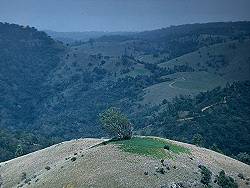Australia - About the Country
Australia, the largest island of the World - or the smallest continent?

Australia lies between Pacific Ocean and Indian Ocean on the southern hemisphere. With a size of 7.7 Million km², and a population of about 18 Million people it is a country which is surrounded completely by the sea. Some call it the smallest continent on Earth, others the biggest island. Beneath the mainland, several islands belong to Australia, the biggest of them is Tasmania. The Capital of Australia is Canberra, other big cities are Sydney, Melbourne, Brisbane, Perth, Adelaide, Hobart, and Darwin. The mainland is divided into six states, the Capital Territory and one independent "country", the Hutt River Province Principality.

Australia was first colonized by man about 40,000 years ago. Tribes, coming by boat from Asia brought with them some plants and animals, for example the dog which adapted and is now called dingo. This people lived all this time in an extremely stable hunter-gatherer society. They have a unique culture and produced many high quality cave paintings. They are called Aborigines, which is just another word for natives.
About two hundred years ago Australia was seized by Europeans, especially from Great Britain. The country was first used as a remote penal colony, later it was colonized by British settlers. As often during history, the natives were pursued, dispelled and killed. On the other hand Australia lead the way to reimburse their descendants for this injustice during the second half of the 20th century.
Being separated from the other continents for many millions of years, the fauna and flora of Australia developed in a completely autonomous evolution. The typical trees of Australia are the Eucalyptus trees, a large genus of myrtle trees (Myrtaceae). They are also known as gum trees or stringybark trees. More than 500 different species exist, most of them produce certain volatile oils, which are commonly used as drugs, especially against cold and headaches.
Typical Australian animals are the marsupials, which were extinct on all other continents, but developed well in Australia and fill all ecologic niches inhabited by mammals in the rest of the World. This family of animals give birth to live young, which are immature and live several weeks or months in the marsupium of the mother. The most famous marsupials for foreign tourists are kangaroo and wombat. Many marsupial predators are completely or nearly extinct, like the Tasmanian devil, most of them because of human intervention, others because of climatic changes.
Other animals, Australia is famous for, are the birds. The Emu is a huge flightless bird, similar to the African ostrich but a bit smaller. Other typical birds are the various kinds of cockatoos, a sort of parrot. It was named after the Gagadjoo area in Northern Australia, today a famous National Park.
The country is divided into four different climatic regions:
- Along the east coast, in the south-east around Melbourne and on Tasmania the climate is temperately humid with a dry and a wet season. This is the area with the highest population. It is divided from the centre by a mountain ridge running north to south through the whole continent.
- Along the west coast is a small band of fertile land, which gets rain the sea. The climate is similar to the Mediterranean climate.
- The whole centre of Australia is desert. Is it also called the red centre, as most of the rocks are red sandstones. Rains are very rare, they happen only once a year or even more unfrequent.
- The north and the northeast are wet and subtropical, covered by rain forrest.
- Additional Information about Australia
 Tourist Travel & Holiday Guide Australia (visited: 04-APR-2025)
Tourist Travel & Holiday Guide Australia (visited: 04-APR-2025) Australian Speleological Federation Inc. (ASF) (visited: 04-APR-2025)
Australian Speleological Federation Inc. (ASF) (visited: 04-APR-2025) Destinations: SHOW CAVES (visited: 04-APR-2025)
Destinations: SHOW CAVES (visited: 04-APR-2025) Australasian Cave and Karst Management Association Inc. (ACKMA) (visited: 04-APR-2025)
Australasian Cave and Karst Management Association Inc. (ACKMA) (visited: 04-APR-2025)
 Index
Index Topics
Topics Hierarchical
Hierarchical Countries
Countries Maps
Maps Search
Search